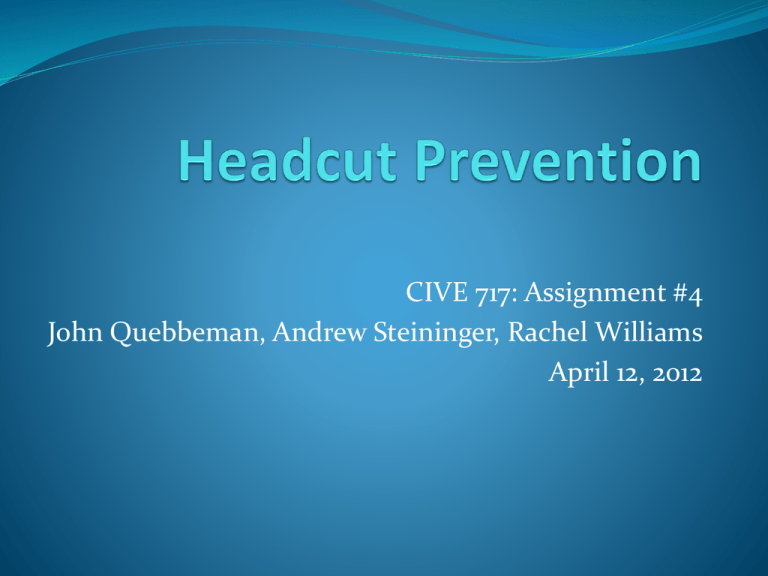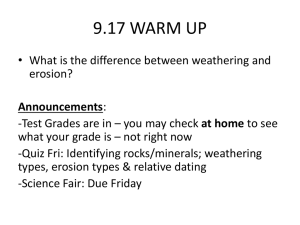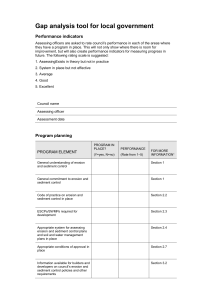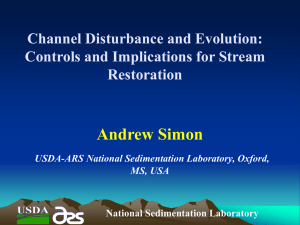Headcut Prevention
advertisement

CIVE 717: Assignment #4 John Quebbeman, Andrew Steininger, Rachel Williams April 12, 2012 This presentation is presented in three sections: Headcut Equations- John Quebbeman Physical Process and Model- Andrew Steininger Design and Prevention Methods- Rachel Williams April 12, 2012 Headcut Equations Hydraulic Equations Sediment Transport Equations Numerical Models (SITES) Empirical Quantification Photo Source: WES Stream Investigation and Streambank Stabilization Handbook, US Army Corps of Engineers, October, 1997 Hydraulics Critical Depth – Occurs over top of headcut Normal Depth – Commonly assumed for downstream channel below headcut hc 3 q2 g 1.5 Vn hn 1/ 2 S Used for Shear Stress Calculations Shear Stress – Bed Shear used for determining transport capacity hc=critical depth hn=normal depth V=velocity n=Manning Roughness g=gravitational constant S=Friction Slope h=depth γ=Specific Weight hS Sediment Transport Downstream Erosion & Channel Deepening Sufficient Capacity to Transport Bed Sediment d sc 10hS Supply<Capacity, Simplified Estimate Transport Capacity Estimates (Julien, 2002) Sediment Discharge by Volume Qs 18W g ds3/ 2 *2 Approaches may be used to find unstable channel conditions Numerical Model Software Available for Calculating Headcut USDA – NRCS developed SITES Model Mainly developed for Headcut Calculation of Earthen Embankments (may be applied for instream applications) Headcut Phases in SITES Model Phase 1 – Erosion of Vegetal Surface Layer Phase 2 – Deepening of erosion, Start of Headcut Phase 3 – Headcut Migration Upstream SITES Model - Phase II USDA Ch. 51, Part 628 Dams, Earth Spillway Erosion Model Surface Detachment Partial Vegetal Cover Erosion Deepening Erosion Rate Effective Shear w/ Partial Vegetal Cover Shear Stress Erodibility Coefficient SITES Model – Phase III Phase III Erosion Check for Maximum Shear: Depth >Critical Depth Upstream Advance & Deepening Checks for Normal Depth Shear vs. Drop Shear Normal Depth Shear Drop Depth Shear SITES Headcut Advancement Phase III Erosion Headcut advances upstream if threshold exceeded <A0 is No Movement Based on Shields Approach for Incipient Motion SITES Hydraulic Jump Stress Estimate Uses Simplified Horizontal Assumptions Normal Depth in Downstream Channel Energy Slope & Sequent Depth used to determine Shear Stresses SITES Erodibility of Multiple Layers Erodibility Index Kh Steps through time considering eroded layer i Composite Erodibility Index Thickness Layer ‘i' Erodibility Index Layer ‘i’ Total Thickness Empirical Headcut Advancement Rate Studied in SW US Migration Upstream F(x) of Precipitation times Drainage Area May vary with different regions Rieke-Zapp, D., Nichols, M. Headcut Retreat in a Semiarid Watershed in the Southwestern United States Since 1935, Catena, Vol 87, Issue 1, October, 2011. Watson etal 2007 Stream Rehabilitation Headcutting Causes: Natural: Base level drop Earthquakes or tectonic processes Ground water sapping Topographically caused ground water concentration piping Change in sediment regime fire induced runoff Draught or Flooding Human Induced: Change in sediment regime Increased sediment input to a reach from agriculture or timber harvest Decreased sediment input to a reach due to stream bank armoring Change in flow regime Increased runoff from urban areas Change in base level Change in output elevation/water level (i.e. reservoirs) The overall controls on headcutting conditions Streams naturally tend toward a state of “dynamic equilibrium”. This state is typified by the following characteristics: • Longitudinally uniform energy dissipation (limited local areas of large energy head change) • Sediment continuity (the sediment input to a stream equals the output) • A sediment capacity supply ratio (CSR) of 1 • Constant Slope (no substantial aggradation or degradation) Lane’s Balance represents the balance of driving variables in a stream system http://weltanschuuang.blogspot.com/2009_11_01_archive.html Natural Stability and Headcut Prevention Headcuts can be prevented by maintaining the natural watershed condition with regard to flow, sediment and slope. http://myweb.cwpost.liu.edu/vdivener/notes/streams_basic.htm The Local Physical Mechanism for a Headcut Increased flow velocity over a headcut continues erosion at the head cut depth in the upstream direction manifesting the head cut feature head ward. Example of a numerical model simulation of the headcut flow http://www.agu.org/journals/wr/wr0509/2004WR003752/ Diagram of water level and energy distribution at a headcut Physical Modeling of the Headcutting Process http://www.colorado.edu/geography/geomorph/rosenberry/ Common Drainage Patterns Caused by Head ward Erosion Trellis – form in repeating layers of stronger and weaker substrate material Rectangular Pattern – form in bedrock which is jointed at 90 degree angles Dendritic Pattern– form in homogenous landforms where substrate material has no control over flow direction Ground water Seepage Headcutting Dunne, 1980. (a) A stream valley erodes into a headland, causing a slight deflection and concentration of ground-water discharge; (b) the concentrated ground-water discharge results in sapping which erodes a small cut into the side of the headland, which further concentrates groundwater discharge and sapping; (c) the newly formed headcut erodes further, and sidecuts may develop and erode in the direction of sediment jointing or faulting. http://www.colorado.edu/geography/geomorph/rosenberry/ Base level lowering Headcut Headcutting is commonly a mechanism for channel adjustment to a large scale change in slope. http://www.colorado.edu/geography/geomorph/rosenberry/ Channel Widening Headcutting can cause downstream incision and bank failure causing channel widening Watson etal 2007 Stream Rehabilitation Headcutting is out of this world! Short, deep, stream-like channels on Mars may be the result of ground-water sapping (Gulick, 2001). Features on Mars generated substantial interest in studies of ground-water sapping during the 1980s and early 1990s. http://www.colorado.edu/geography/geomorph/rosenberry/ This section discusses considerations for the prevention of forming headcuts and the control of existing headcuts. Headcuts can be described with a channel evolution model. Ideally they should be controlled at Phase 1 before they begin or before Phase 3 when bank failure occurs. Headcut Prevention Preventing head cuts can be done by avoiding practices that cause change in hydraulic or sediment continuity including: •Straightening channels (ΔSo) •Gravel mining (ΔD50) •Land Use change (ΔQ & D50) inc. Farming, road construction, grazing, mining, urbanization Bledsoe, Stream Rehabilitation, 2011 Mitigating Land Use Change Land Use change cannot always be avoided but the impacts on flow regime change can be mitigated with stormwater management by: •encouraging groundwater infiltration •retaining storm runoff and slowly releasing it •natural plant cover buffers around streams http://landscapeandurbanism.blogspot.com / http://www.apexnc.org/services/public-works Grade Control Structures Existing headcuts can be controlled with grade control structures placed either above or below the headcut. The structure causes the aggradation of sediment above it and decreases the bed slope from S1 to S2 as in the figure. Height of structure = (S1-S2)*L The equilibrium bed slope (S2) is found by analyzing the stable slopes for a sediment transport rate. Methods such as SIAM and Copeland’s can be utilized. Types of Grade Control Structures In choosing the type of structure you must consider frequency and number of structures and other criteria such as cost, material availability, environmental impacts, and risk. Some examples include: •Large, single drop structures •Drop box culvert •Smaller drops (Sheet pile, rock, gabien) •Rock Ramps (Newbury riffles) •Rosgen structures Chester Watson, USACE Large single-drop structure Grade control for large head cuts can be achieved with single large structures. Advantages: •Only one structure •Lower risk of failure •No scour hole with concrete slab Disadvantages: •Expensive •No fish passage •Flood management •Appearance Chester Watson, USACE Drop Box Culvert A drop box culvert controls a hydraulic jump at a bridge structure. It is similar to the previous example Advantages: •Only one structure •Limits risk to bridge infrastructure •No scour hole with DS concrete slab Disadvantages: •Expensive •No fish passage •Flood management •Appearance Chester Watson, USACE Smaller Weir Structures Grade control for a head cut can also be achieved with smaller, cheaper structures. Depending on the scenario one or more weirs may be necessary. They can be constructed using various materials. Locally they are often large rocks. Sheet Pile Weir: Useful when rock is not readily available, but can still prevent fish passage Chester Watson, USACE Rock Gabiens: The gabiens function as a weir and are cheaper than large rock but are more succeptible to erosion failure Smaller Weir Structures Rock ramps dissipate energy over a longer area with large rocks Advantages: cheaper, can allow fish passage, natural looking Disadvantages: requires rock, rocks may more in large floods Newbury Riffles (below) are another example of rock ramps that allow fish passage and grade control. Newbury, Newbury Hydraulics Chester Watson, USACE Smaller Weir Structures Rosgen has designed several structures that are used as grade control including cross-vanes, J-hooks, and W-weirs. They are constructed of large rocks, and often can allow fish passage. Rosgen, Wildland Hydrology











